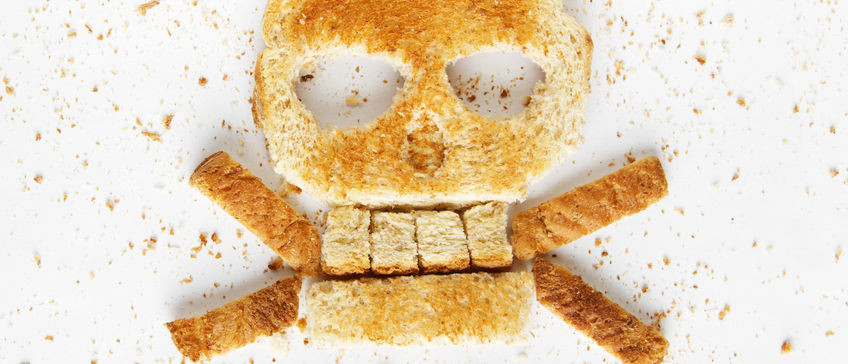
Those of us in the food industry should find this statement alarming: “Human hair, chicken feathers, and high-fructose corn syrup—if you eat packaged bread from the supermarket, these ingredients have likely been in it. In fact, plenty of packaged bread sold in the United States contains ingredients that are banned in lots of other parts of the world.”1 I am not suggesting whether the author is incorrect or not; this is just one example out of thousands currently posted all over the Internet.
Large food chains such as Subway and Chipotle have decided to remove ingredients consumers consider carcinogenic, synthetic, or just plain weird.2 In the baking industry, preservatives are used to keep foods looking and tasting fresh longer and preventing them from spoiling. Even if we know that some rumors are unfounded – like the idea that food scientists are making bread out of the same material found in yoga mats – we need to address consumer concerns.
What to do with food additives?
The current reaction, as exemplified by Subway, is to remove the objectionable ingredients.2 Of course, removing preservatives from baked goods can be time-consuming and expensive. However, this movement has quickly gained momentum and is associated with the clean eating and clean label movement.
I suggest we add a third tier to this movement as manufacturers, and increase transparency and education about the ingredients we use and the functions they perform. Providing consumers with well researched documentation on these ingredients would allow an open discussion. It is time for those in the food industry to be accountable for the choice of ingredients we use in commercial manufacturing. If we use these ingredients, let’s share the information and discuss why we use them.
The following ingredients are the most commonly discussed on consumer peer-to-peer websites:
Azodicarbonamide
Azodicarbonamide or ADA is an additive used to enhance the texture of soft breads such as hamburger buns. ADA has generally recognized as safe (GRAS) status and can be added to flour at levels up to 45 ppm.3 The use of ADA is still acceptable in the US. However, it has been banned in Australia and Europe. Major issues of concern are respiratory health and allergic reactions.1
Potassium bromate
Potassium bromate is used as a dough conditioner, to create greater dough volume and to help strengthen the gluten network.4 The use of this ingredient has decreased since the 1990’s due to its status as a potential carcinogen.4 It is usually replaced with clean label solutions using ascorbic acid. Because of the link between potassium bromate and cancer, it has been banned in the EU, Brazil, Peru, South Korea, and China.1
Calcium propionate
Calcium propionate is used in bread as a food additive. It is employed in combination with propionic acid to inhibit the growth of mold and bacteria to extend shelf life.5 Calcium propionate in the diet has been blamed for headaches, stomach issues, and behavior changes in children.6
More common ingredients that turn consumers away from a label are high fructose corn syrup and refined grains.
According to the article “9 Hidden Facts the Food Industry Doesn’t Want You to Know,” food scientists are out to cause illness and addiction with the foods they create, and food companies are like well-oiled propaganda machines.7
Due to the proprietary nature of formulas, the food industry has not historically provided consumers with all the information regarding the use of certain ingredients. With diet-related health issues increasing, more attention is being focused on processed food. Consumers will find ready answers from those willing to eliminate all processed foods. It is time to open the dialogue – not just by reformulating and removing ingredients, but by sharing the research and explaining why we use the ingredients we use.
References
- Vilibert, D. “5 Harmful Additives in Bread.” 5 Harmful Additives In Bread | Care2 Healthy Living, 1 Jan. 2014, http://www.care2.com/greenliving/5-harmful-additives-in-bread.html.
- News/AP, CBS. “Subway: No more ‘yoga mat’ chemical in our bread.” CBS News, CBS Interactive, 11 Apr. 2014, www.cbsnews.com/news/subway-no-more-yoga-mat-chemical-in-our-bread/.
- “Azodicarbonamide (ADA) | Baking Ingredients.” Bakerpedia, bakerpedia.com/ingredients/azodicarbonamide-ada/.
- Bakerpedia. “Potassium Bromate | Baking Ingredients.” bakerpedia.com/ingredients/potassium-bromate/.
- Sanchez, M. “The Best Preservatives for Bread.” LEAFtv, www.leaf.tv/articles/the-best-preservatives-for-bread/.
- Thatcher, E. “The Side Effects of Calcium Propionate.” LIVESTRONG.COM, Leaf Group, 20 Apr. 2015, www.livestrong.com/article/314019-the-side-effects-of-calcium-propionate/.
- Sibaja, A. “9 Hidden Facts the Food Industry Doesn’t Want You to Know.” LIVESTRONG.COM, Leaf Group, 16 Nov. 2016, www.livestrong.com/slideshow/1011186-9-hidden-food-industry-doesnt-want/#slide=1.

